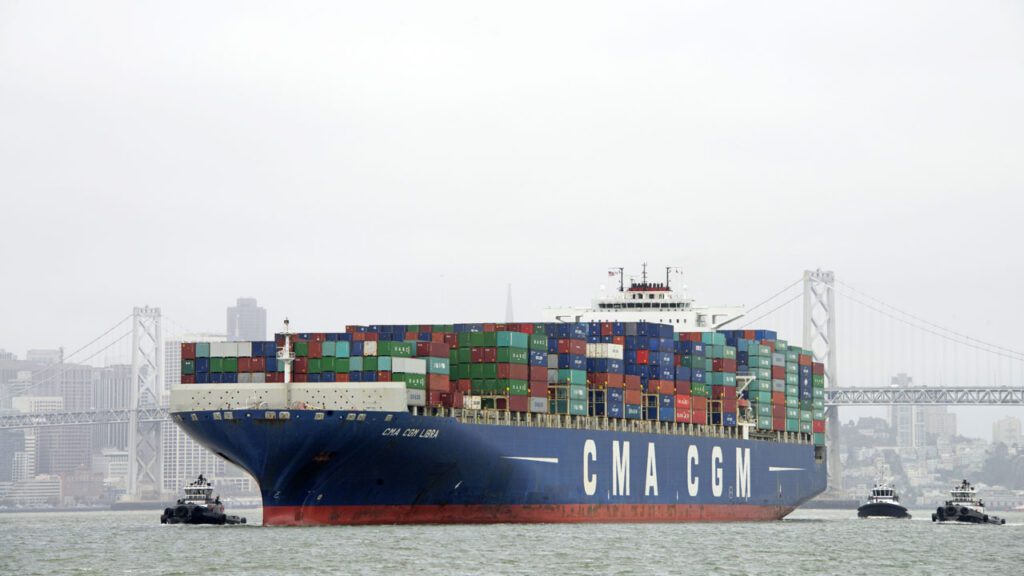Introduction
MM members have previously been alerted to the critical importance of Passage Planning (PP) by MM Risk Bulletin No. 27. This included the decision of the English Admiralty Court in the ‘CMA CGM Libra’ (CCL) case that the CCL’s defective PP rendered the vessel as ‘unseaworthy’. This decision was subsequently upheld on appeal to the Court of Appeal (CA). It was recently confirmed by the Supreme Court (SC).
It is now clear that, in English law (including all contracts subject to English law), a defective Passage Plan (PP) can result in a vessel being ruled as ‘unseaworthy’. This Risk Bulletin further explains the potentially negative impact on shipowner Members of such a ruling. It also reviews the circumstances of the CCL grounding and the ‘lessons learned’ from this incident.
Background
In May 2011, the CCL (a cellular container vessel of TEU 11,388) left the port of Xiamen, China, bound South for Hong Kong. After disembarking the pilot, and while navigating out to sea through a dredged and buoyed fairway channel, the Master made a sudden and unplanned course deviation outside of the channel into what he believed was deeper water.
The CCL subsequently grounded on an uncharted shoal. Salvage and other assistance were required to re-float the vessel and preserve her cargo at a total cost of about USD 13 million.
The CCL’s owners declared General Average (GA) and 92% of cargo interests paid their contributions in GA. However, 8% of cargo interests refused to contribute on the grounds that:
- There had been a breach by the shipowner/carrier of the principal obligation of the carriage contract in that the CCL was ‘unseaworthy’ before and at the beginning of the voyage.
- This breach was an ‘actionable fault’ and, as provided by Rule D of the York Antwerp Rules which regulate GA contributions and settlement, this entitled cargo interests to decline to contribute to GA.
The allegation of unseaworthiness by the 8% of cargo interests was based on a number of causes. However, the primary cause was alleged to be a defective PP which rendered the vessel ‘unseaworthy’ before and at the beginning of the voyage. Further, that this defect was directly causative of the grounding.
Owners refuted these allegations and argued that the cause of the grounding was ‘negligent navigation’ for which (as explained below) they were not liable.
‘Unseaworthiness’ or ‘Negligent Navigation’ as the cause?
As a starting point, the Hague or Hague Visby (HV) Rules and their stipulated carrier obligations and potential exemptions from liability will normally be incorporated into both the Bill of Lading and/or Charterparty carriage contract terms. These Rules applied in the case at hand.
In particular, the Hague/HV Rules Art III, Rule 1, provides that the ‘principal obligation’ of the shipowner/carrier is to ‘… exercise due diligence to make the vessel seaworthy before and the beginning of the voyage.’ If the shipowner/carrier can show they have met this obligation, they will then be entitled to rely on the exemptions from cargo loss or damage liability provided by the Hague/HV Rules Art IV, Rule 1, ‘unseaworthiness’ and Rule 2 (a), ‘negligent navigation’.
NOTE: The Hague/HV Rules ‘principal obligation’ of the shipowner is clearly established in English law as being a ‘non-delegable duty’. As such, any failure of due diligence by the Master and crew will be construed as the failure of the shipowner.
If the shipowner/carrier fails to prove the exercise of the requisite due diligence, they will be in breach of their carriage by sea ‘principal obligation’ and will not be entitled to rely on the Hague/HV Rules exemptions from cargo damage and loss claims as a complete defence to liability. Further, the ‘actionable fault’ provision of Rule D of The York Antwerp Rules will engage to entitle cargo interests to refuse to contribute to GA.
NOTE: English law has long provided that a vessel may be rendered ‘unseaworthy’ not only as a consequence of defects in the vessel’s hull and equipment but also as a consequence of Master and crew incompetence, defective documentation or a failure to carry updated charts and publications. However, prior to the CCL case, there was no decided case law as to whether a defective PP could render a vessel ‘unseaworthy’ before and at the beginning of the voyage.
The principal issues to be determined in the CCL case were therefore (1) whether or not the vessel’s PP was defective and, if so, (2) whether this deficiency rendered the vessel as ‘unseaworthy’ before and at the beginning of the voyage and, if so, (3) whether the defective PP / unseaworthiness was causative of the grounding.
Relevant facts of the CCL grounding
The facts of the CCL grounding are contained in the 33 page Admiralty Court law report where the case was first heard. A summary of key facts is provided below.
CCL’s Navigational Equipment
The CCL was fitted with all requisite navigational equipment. This included an Electronic Chart Display System (ECDIS) which was installed with C-Map Pro Plus Electronic Nautical Charts (ENCs). However, in 2011 (and up until the year 2016), the provision of an ECDIS unit was not mandatory for a ship of the CCL’s size and vessel type. As such, the primary and regulatory compliant chart system on board the CCL continued to be provided by British Admiralty (BA) Standard Nautical Charts (SNCs), commonly referred to as ‘paper charts’, which were required to be updated from BA Notices to Mariners (NMs).
Port of Xiamen and Passage Plan
The entrance channel to the Port of Xiamen consisted of a dredged and swept channel marked by light buoys. BA NMs and Admiralty Sailing Directions advised that the areas outside of the dredged channel contained unmarked wrecks, mine fields left over from World War II and unmarked shoals.
As noted earlier, the 2nd Mate (who, as is usual on-board merchant ships, also acted as the Navigator), prepared a PP on both the owner’s standard form and as transferred to the working paper charts. This was done on 17 May 2011, before the CCL departed the berth. It provided for the CCL’s exit out from Xiamen to the sea through the same buoyed channel through which the vessel had entered the port. It was confirmed as being satisfactory by the Master’s signature.
The information on the paper chart in use at the time of the grounding, BA Chart 3449, was subject to three NMs; two issued in Dec 2010 and another in April 2011, only a few weeks before the incident. All of the chart corrections required by these NM’s appear to have been entered on to the CCL’s BA chart 3449.
NTM 6274(P)/10 appears to have been highly relevant in that, in addition to advising of previously unknown shallow areas outside of the channel, it also contained a para. 2 warning that: ‘numerous depths less than charted exist within and in the approaches to Xiamen Gang’.
The aforesaid NM warning supported the text of the Admiralty Sailing Directions which explained that the existence of former minefields had inhibited hydrographic surveying such that ‘…outside the swept routes there may be many uncharted wrecks and isolated shoals especially dangerous to deep draught vessels.’
It should be noted that no details or any reference to the above warnings appeared in the CCL’s PP text or on the BA chart 3449 in use at the time. Nor had any pencil hatching or other marking been drawn on the chart to indicate, as recommended by industry best practice voyage planning publications and IMO Guidelines, the existence of ‘No Go’ danger areas outside of the buoyed channel.
Navigation of the CCL
The CCL left the berth at 0133 hrs on 18 May 2011. This was shortly after high water. The CCL’s draft was 15.5 M. The tidal range on that day was 5.0 M. Vessel ‘squat’/increase in draft while underway in the channel was estimated to be 1.8 M. By reference to a tide height calculation (which was not entered on the PP form), there would be an adequate Under Keel Clearance (UKC) of 2.5 M within the advised 14.0 M low water/ minimum depth of the buoyed channel during the CCL’s PP transit out from the Port of Xiamen to the sea.
The local pilot was disembarked outbound at Buoy No.19. Before leaving, he confirmed that the least depth in the buoyed channel was 14.0 M. The Master then took over the navigational conduct of the CCL. He was assisted by the 2nd Mate/Navigator who had prepared the PP and was also the watch officer. The CCL was being steered manually and a helmsman was at the wheel.
The CCL’s position was being plotted from time to time by the 2nd Mate on the BA 3449 paper chart. Additionally, the ECDIS unit was switched on and the Master was using this display and the ARPA radar to observe the vessel’s position and progress.
NOTE: Readers may now wish to refer to the annotated PDF BA chart 3449 and the Key Position Points (KPP) 1. to 5. it contains and which is attached to this Risk Bulletin
At 0220 hrs. (KPP 1.) the CCL was proceeding at about 13 knots on a course of 135º. She was located at just under 1 cable (1/10th of a n. mi.) to the SW of the charted PP course line of 134º. The intention appears to have been to keep Buoy No 15 well clear to port and well away from a 6.4 M. shallow patch shown on the chart just to the North of that buoy.
At 0222 hrs. the 2nd Mate marked the CCL’s position on the paper chart. It seems the Master’s intention at that time was to edge the vessel towards the port/Eastern side of the channel so as to leave Buoy No. 14 -1 well clear to starboard. This intention was consistent with the approved and charted PP courses.
At 0225 hrs. (KPP 2.), the Master, without first conferring with or alerting the 2nd mate, made a sudden and radical navigational decision to alter the CCL’s course to starboard and deviate from the PP by leaving Buoy No 14-1 to port.
But why? The Master later stated he deviated from the approved and charted PP because VTS had cautioned him by radio – when the CCL was inbound in the channel the previous day – of reported shallow areas lying ahead of the CCL and to the East of Buoy.14 -1. It seems that the Master’s understanding of the VTS advice was that these reported ‘shallow areas’ lay inside the buoyed channel.
NOTE: It later transpired, during the course of investigation, that the ‘shallow areas ahead and to the East’ which VTS had referred to actually laid outside of the buoyed channel.
As described by the Admiralty Judge:
“The aim of this somewhat striking change of helm, through almost 40 degrees, was to pass buoy 14-1, and the [perceived] danger area around it, to port. Not only did this take the vessel out of the fairway marked by the magenta pecked lines on the channel but also took the vessel out of the buoyed fairway.”
After passing Buoy No. 14-1 to port (KPP 3), the Master next ordered ‘hard to port’ in an apparent attempt to re-enter the dredged channel and then leave the next buoy, Buoy No. 14, to starboard. The resulting rate of the CCL’s turn was very slow. The Master then appears to have realised that it was impossible to re-enter the channel without running over Buoy No. 14.
At 0228 the Master next ordered ‘hard to starboard’ with the intention of leaving Buoy No.14 to port and then entering a narrow channel between a lighted rocky islet, Juie Jiao, and the small island of Wu Yu.
At 0234 (KPP 4.) the vessel’s speed dropped suddenly. It was apparent that the CCL had gone hard aground on a shoal. It later transpired that the shoal it grounded on was not marked on the CCL’s paper chart BA 3449. This was because its existence and position (although already known to both the Chinese and the British Admiralty authorities) had not yet been formally promulgated by an NM designed and intended to update paper charts.
NOTE: What was displayed on paper chart BA 3449 (KPP 5.) was a shoal sounding of only 1.6 M. lying less than 1 cable to the west of the position where the CCL grounded. This was a recently discovered shoal which had been clearly marked on BA chart 3449 by reference to NM 1691/11 of April 2011. This showed – in itself and without a further NM to depict the shoal the CCL actually grounded on – that any attempt to navigate the CCL, with a draft of 15.5 M., through the channel between Juie Jiao and Wu Yu would be extraordinarily dangerous.
Admiralty Court’s Assessment, as later confirmed by the CA and the SC
The findings of the Admiralty Court may be summarised as follows:
- The PP was defective for several reasons. The primary deficiency was that the PP did not include a reference to and a summary of the content of the NMs which warned of water depths outside the buoyed fairway being less than those charted. In particular, the PP laid out on BA chart 3449, did not contain a pencilled in and clearly visible summary note of the NM warnings (i.e. a ‘No Go’ or ‘Danger Area’ advice) for quick and ready reference by the Master and OOW during the active navigation of the vessel.
- The defective PP rendered the vessel unseaworthy because – following a long-established legal test – a prudent owner would have required the PP to be rectified before the commencement of the voyage. (McFadden v Blue Star Line [1905] 1 KB 697)
- The requirement to exercise due diligence to make a vessel seaworthy before and at the beginning of the voyage was a personal and non-delegable duty on the owner, regardless of who the owner had tasked to accomplish it (in this case the Master and 2/O). (McFadden v Blue Star Line [1905] 1 KB 697)
- The defective PP and resulting unseaworthiness was causative of the grounding as the Master had admitted during cross examination that, had he known of the NM warning, he would not have left the buoyed channel.
- The shipowner/carrier had breached the contract of carriage ‘principal obligation’, as provided by the Hague/HV Rules Art III, Rule 1, in that the owner had failed to exercise their non-delegable duty of due diligence to make the CCL seaworthy before and at the beginning of the voyage.
- As such, the exemptions from cargo liability provided by the Hague Rules Art IV, Rule 1 ‘unseaworthiness’ and Rule 2 (a) ‘negligent navigation’ were not available to the owners. In turn, and by reference to Rule D of the York Antwerp Rules, this provided cargo interests with an ‘actionable claim’ against owners and the entitlement to decline to contribute to Salvage and/or GA costs.
Conclusion and Takeaway
The English Supreme Court’s (SC’s) confirming decision in the CCL case now represents binding precedent which must be followed – unless it can be distinguished (differentiated) on the facts – by all other courts or arbitration panels which are subject to and/or are deciding disputes governed by English law.
Courts and arbitration panels in other common law jurisdictions, such as Singapore, Malaysia, Hong Kong and New Zealand, will not be compelled to follow the SC’s decision. However, following established legal practice, they may well choose to consider it as ‘persuasive authority’ and be guided accordingly.
The impact on MM Members who carry cargo under either bill of lading and/or charter party carriage contracts which are subject to English law is that, in circumstances where the PP is shown to be both defective and causative of the loss, it will now be much more difficult to defend cargo claims by reference to the Hague/HV Rules exemptions from liability. Additionally, Members may also find themselves unable to require cargo interests to contribute to Salvage costs and/or GA.
For members carrying cargo under terms subject to the law of other common law countries, they may also be impacted in a similar manner.
In the circumstances, and by reference to the CCL ‘lessons learned’, Members are encouraged to action the following loss prevention measures by ensuring that:
- The PP recommendations contained within RB No. 27 have in fact been fully implemented throughout their fleet and that compliance is being audited by each vessel’s DPA during ship visits and annual SMS audits.
- Consideration is given to requiring copies of approved and signed PP’s being transmitted by Masters to ship managers and DPA’s prior to departure from all ports as an on-going check on compliance.
- All Masters are reminded they are obligated to conduct a comprehensive assessment of all PPs presented to them for their approval and signature. In particular, Masters must check that all PPs include the latest navigational information available and are in full compliance with current IMO Guidelines and industry best practice manuals.
- Masters and Deck Officers are reminded that they should never deviate from the PP unless they are faced with a genuine and immediate emergency and, only then, after all members of the bridge team have first been fully advised.
Finally, Members are respectfully reminded that (as detailed in RB No. 27), the requirements for Voyage/Passage Planning are contained within SOLAS Chap. 5, Safety of Navigation, IMO Res. A.893(21) and the STCW, Section A-VIII/2, Part 2. Members are also reminded that full compliance with these regulations and guidelines is a warranty obligation under the terms of the MMIA General Rule No. 26, paras (f) and (g).


